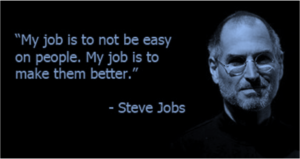The Point: Why study communication skills of great leaders? Well, simply because great communication is one of the major denominators (if not the only one) between social, political, and business leaders across the globe. And since we stress so much on communication skills training for leaders, it is only logical that we take some cues from those in key organizational positions that are performing at what we consider to be a ‘great’ level. Simply put, if you want to excel as a leader in your organization/industry, make sure you have the following 10 key communication skills embedded in your leadership toolbox… Enjoy!
#10 Engage With Your Workforce
As an executive, you may have to send emails and memos to your workforce on a regular basis. But whenever you get the chance, forego corporate communications and engage with dialog with others. When you engage with people in conversation (as compared to monologues), you automatically increase the effectiveness of the message.
#9 Gather Facts Before Taking Action
This follows from the previous leadership communication point. When you engage with your workforce on a regular basis, you will generate honest feedback instead of sanitized versions of the truth. The benefit is that during times of conflict, you will have all the facts needed to thoroughly evaluate the situation. As a result, you will make impartial decisions as compared to executives who are so detached from their subordinates that all they get is one-sided information.
#8 Clarity is King
In today’s corporate world, time is a rare commodity, especially if you are operating in a highly competitive industry, or one that is constantly undergoing change, such as technology. If you need to make split-second decisions and want your employees to be informed of a change in company policy, then just get straight to the point. This is especially true if you are relaying bad news, such as a drop in cash flow. Get some pointers on getting straight to the point from Churchill’s WWII speech: ‘the news from France is very bad….’
#7 Speak Only to Add Value
Improving your leadership communication skills is an essential part of leadership development, but this does not mean that you increase the frequency of speaking to your workforce. Speak only when it’s necessary, and do so only to add to the listener’s experience. Otherwise, people will come to resent your interactions.
#6 Welcome Criticism
This is the true mark of the leader. The leader doesn’t shun or shout down dissenting opinions. Instead, he welcomes as an opportunity to learn more about what people around him are actually thinking. This takes us to the next point…
#5 Listen More
Great leaders know that communication isn’t one-way traffic. There is great wisdom in listening to what others have to contribute to a discussion, even though you may have the final say. In fact, just by the (not so) simple act of listening, you will learn a lot, which is necessary to stay on top of your game.
#4 Body Language and Eye Contact
Communication doesn’t only refer to strong oratory skills. You also have to take non-verbal cues into account, especially body language and eye contact. The way you stand, your hand gestures, and your eye contact with your audience plays a major role in the receptivity of the message.
#3 Body Language of the Audience
Conversely, you also have to pay attention on the body language of the listener. Also try to take cues from his facial expressions to gauge if he truly understands the message.
#2 When you Speak to All, You Speak to None
When your messages are directed to everyone without any specificity, people will have an excuse to avoid personal responsibility. However, since leaders not always have the luxury of dealing with people in one-to-one settings, you should the develop the habit of tailoring your messages in a way that each person in the room feels that you are talking to them.
#1 Know your Material
Finally, if you want to command authority from your listeners, you need know your material really well. Only when you have subject expertise can you get people getting interested in what you have to stay, and this will positively influence the response you get.
Summary
Communication skills are essential if you want to mature as a leader. The job of a C-Suite executive is not an easy one as s/he has to hold their organization together, and this is only possible via robust communication skills.
If you’d like more information about Tip of the Spear’s Business Advisory Services, consisting of Centered Executive Coaching, Leadership Development through ‘The Leadership Challenge’ methodology, and Communication Skills Training for Leaders use the CONTACT US page of this website.




